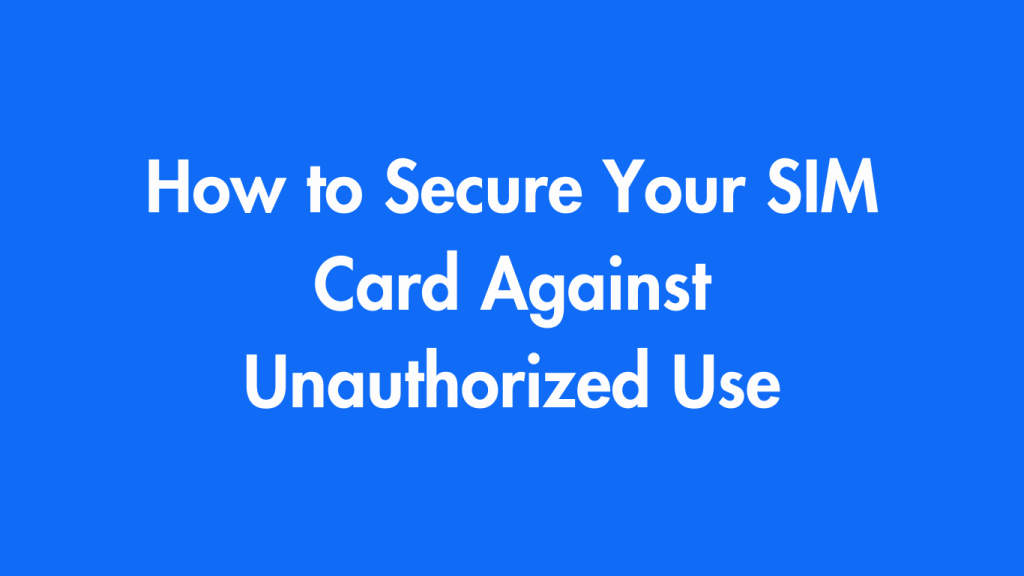SIM cards are required for connecting your mobile phone to the network. This is necessary when you wish to make calls, send texts, or transfer files. It can also be used to acquire unauthorized access to your account through fraud schemes like SIM switching and identity theft.
This post will teach you how to prevent your SIM card from being exploited. It contains suggestions for implementing biometric authentication, PINs, and other precautions.
Set Up a SIM Card PIN
Setting up a PIN is one of the most effective ways to safeguard your SIM. A PIN provides an additional layer of security by preventing anyone from accessing your SIM card if you remove it from your phone or restart it.
How to set up a SIM PIN in Android:
- Go to Settings.
- Select Security & Privacy or Lock Screen & Security (depending on your phone’s make).
- Tap on SIM Card Lock.
- Toggle on Lock SIM Card and set a PIN.
How to set up a SIM PIN in IOS:
- Go to Settings.
- Tap on Cellular (or Mobile Data), then SIM PIN.
- Switch on SIM PIN to create your PIN.
If you have set up a SIM PIN, you will be prompted to enter it every time you restart your phone or insert your SIM into another device. Choose a PIN that is unique and secure. Use numbers such as “1234” or 0000.
Use Biometric Authentication for Your Phone
However, PIN numbers are a great way to protect both your SIM card as well as the phone itself. Biometric authentication, such as facial or fingerprint recognition, is a highly secure way to do this.
- Fingerprint Recognition: Most modern smartphones have fingerprint sensors which only allow authorized users to unlock the device.
- Facial Recognition: As an added layer of security, facial identification uses your unique facial features in order to unlock devices such as smartphones equipped with Face ID like iPhone.
How to enable biometric authentication
- On Android: Go to Settings > Biometrics & Security or Lock Screen, and set up fingerprint or face recognition.
- On iPhone: Go to Settings > Face ID & Passcode or Touch ID & Passcode, and follow the instructions to enable these features.
The biometric authentication will prevent anyone from unlocking and misusing your SIM card, even if they gain physical access to the phone.
Create a strong passcode for your device
As a backup to biometric authentication and to ensure your phone is protected in the event that biometric recognition fails, or is not available, you should always create a strong device password. If biometric authentication is unavailable or not effective, a passcode will help secure your phone.
- Avoid using simple codes like “1234” and birthdates, which are easily cracked.
- Use a 6-digit code or, to add additional security, an alphanumeric passcode consisting of letters, numbers and symbols.
You should protect your phone with a strong password to prevent unauthorised users from accessing the device and SIM card.
Set Up a Carrier-Level PIN or Password
The majority of mobile carriers offer an extra layer of security through a PIN or password that is different from your SIM PIN. This PIN should only be used to make changes or communicate with customer service.
It is important to set up a PIN with your mobile provider. This will protect you from unauthorized people changing your account information or transferring it to another SIM card.
How to Set Up a Carrier-Level PIN:
- Airtel (Indian): Contact Airtel customer services or use the Thanks app to set or change your PIN.
- Jio (Indian): Create a PIN by using the MyJio App or contacting Jio customer service.
- Vodafone Idea (Vi): Customers: set your account PIN either by contacting the customer service or visiting your nearest Vodafone Idea shop.
It’s best to contact the customer service of your carrier for help due to differences between them.
Enable two-factor authentication (2FA) for critical accounts
Two-factor authentication (2FA codes) sent via SMS is one of the most common ways scammers target SIM card. While SMS 2FA is convenient, it can leave your online accounts vulnerable to SIM swapping. Consider switching to an app-based 2FA (2FA) for increased security.
How to Set Up App-Based 2FA:
Use two-factor authentication applications like Google Authenticator or Microsoft Authenticator to increase your security. Follow the instructions on each service to link your accounts, such as banking, email or social media. Sign in to your accounts using the 2FA app instead of SMS codes.
Even if someone tries to swap SIM cards with you, they will not be able get your authentication code.
Monitor Your Phone’s Activity
If you suddenly lose signal on your phone or it displays “No service”, this could be a sign of illegal activity or SIM swapping. You should follow these steps:
- If you suspect that your SIM card has been tampered with, contact your mobile provider immediately.
- Check your mobile account on the app or online to see if there are any suspicious activities or changes.
Regularly Check for Unauthorized SIM Cards Using TAFCOP Portal
TAFCOP allows Indian residents to check the number of SIM cards registered in their name. This is a vital step for identifying SIMs issued without their knowledge or consent.
How to use TAFCOP portal:
- Go to TAFCOP Portal.
- Enter your active mobile number and request an OTP.
- You’ll see all SIMs issued to you after entering your OTP.
The portal provides a direct way to report any SIM cards that were issued without your consent.
Be Cautious with Your Personal Information
SIM swapping scams often begin with scammers gathering personal information about you. To prevent this:
- Limit sharing personal details online: You should be careful about what you share on social media. Be cautious when sharing sensitive information such as dates of birth, phone numbers and other personal details.
- Phishing attempts: Beware of links and messages that ask for personal information. Scammers may use this technique to collect details to pretend to be you when they call your mobile provider.
Use SIM Lock Features on Dual SIM Phones
Use the SIM lock to secure both SIMs if your phone has dual SIMs. If someone tries to swap one SIM out, they will not be able access the other without knowing your PIN.
Request a SIM Swap Lock from Your Carrier
Customers can request a SIM lock from some mobile carriers. This prevents SIM swaps being processed until you physically visit a store or provide additional proof. This is a good way to prevent unauthorized SIM swaps.
Conclusion
It is important to protect your SIM card from unauthorised use in order to protect both your personal and financial data. You can reduce the risk of SIM Swapping and other fraudulent activities by setting up a SIM PIN and enabling biometrics, using two-factor authentication via apps, and protecting your mobile with a carrier level PIN. Monitor phone activity to identify any abnormal patterns.


